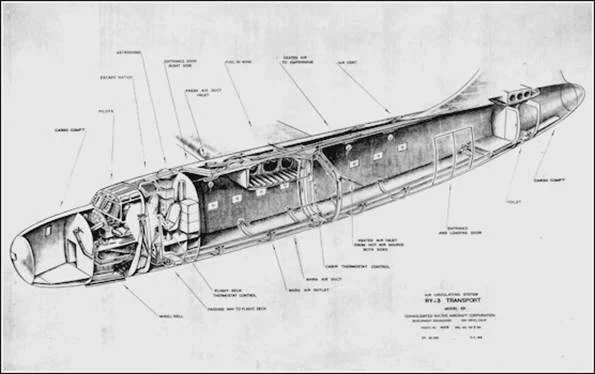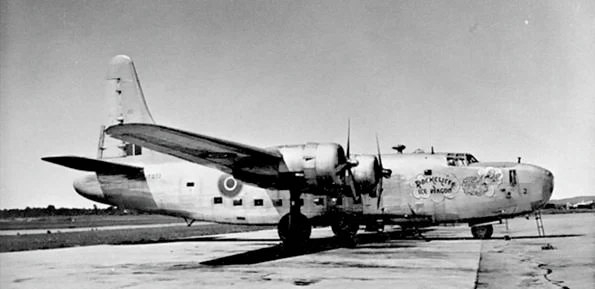 |
| Consolidated R2Y-1 Liberator Liner. |
The Consolidated R2Y Liberator Liner (Consolidated Model 39 redesignated as Consolidated-Vultee Model 104) was an airliner derivative of the B‑24 Liberator built for the United States Navy by Consolidated Aircraft.
Development and Service
The XR2Y-1, as the single prototype was known in Navy service, used the high-aspect wing and tricycle landing gear of the Liberator. The fuselage was an entirely new design, and the vertical stabilizer was taken from the PB4Y Privateer. The final design looked much like a smaller, high-wing Boeing B-29 Superfortress, but with windows for passengers.
The aircraft was meant to carry passengers or cargo to distant Navy bases, but after a brief evaluation the prototype was demilitarized in the mid-1940s, returned to Convair, and leased to American Airlines as a freighter with the name "City of Salinas".
Role:
Prototype military transport aircraft
Prototype cargo aircraft
Manufacturer: Consolidated Aircraft
First flight: 15 April 1944
Status: Experimental
Primary users:
United States Navy
American Airlines
Number built: 1
Developed from: Consolidated B-24 Liberator
Crew: unknown
Capacity:
48 passengers with baggage
1,200 lb (550 kg) of mail
12,000 lb (5,500 kg) of cargo (after refit)
Length: 90 ft 0 in (27.45 m)
Wingspan: 110 ft 0 in (33.55 m)
Airfoil: Davis (22% at root to 9.3% at wingtip)
Gross weight: 56,000 lb (25,000 kg)
Maximum takeoff weight: 64,000 lb (29,000 kg)
Powerplant: 4 × Pratt & Whitney R-1830-94 radial engines, 1,200 hp (900 kW) each
Cruise speed: 240 mph (380 km/h, 210 kn)
Range: 4,000 mi (6,400 km, 3,500 nmi) at 200 mph (322 km/h)
References
Bridgeman, Leonard. "The Consolidated Vultee Model 39." Jane's Fighting Aircraft of World War II. London: Studio, 1946. p. 217.
John Wegg, General Dynamics Corporation. General Dynamics Aircraft and Their Predecessors.
 |
| Consolidated R2Y-1 Liberator Liner. |
 |
| Consolidated R2Y-1 Liberator Liner. |
 |
| Consolidated R2Y-1 Liberator Liner. |
 |
| Consolidated R2Y-1 Liberator Liner. |
 |
| Consolidated R2Y-1 Liberator Liner. |
 |
| Consolidated R2Y-1 Liberator Liner. |
 |
| Consolidated R2Y-1 Liberator Liner. |
 |
| Consolidated R2Y-1 Liberator Liner. |
 |
| Consolidated R2Y-1 Liberator Liner. |
 |
| Consolidated R2Y-1 Liberator Liner. |
 |
| Consolidated R2Y-1 Liberator Liner. |
 |
| Consolidated R2Y-1 Liberator Liner. |
 |
| Consolidated RY-3 Liberator Liner cockpit, 26 April 1945. |
 |
| View of interior of Consolidated R2Y-1 Liberator Liner looking aft and the auxiliary ceiling under the wing. 2 June 1945. |
 |
| View of interior of Consolidated R2Y-1 Liberator Liner looking aft at the auxiliary ceiling under the wing. 2 June 1945. |
 |
| View of interior of Consolidated R2Y-1 Liberator Liner looking aft at the auxiliary ceiling under the wing and the right hand side of the fuselage. 2 June 1945. |
 |
| Passenger seating in the Consolidated RY-3 Liberator Liner. |
 |
| Consolidated RY-3 Liberator Liner in American Airlines livery. |
 |
| Consolidated RY-3 Liberator Liner, “Liberator Liner.” |
 |
| Consolidated RY-3 Liberator Liner in American Airlines livery. |
 |
| Consolidated RY-3 Liberator Liner in American Airlines livery. |
 |
| Consolidated RY-3 Liberator Liner in American Airlines livery. |
 |
| Wind tunnel model of the Consolidated RY-3 Liberator Liner, 4 March 1943. |
 |
| View of interior of Consolidated R2Y-1 Liberator Liner showing passenger seating in commercial version. |
 |
| Interior arrangement of commercial passenger transport version of Consolidated R2Y-1 Liberator Liner |
 |
| Tire failure on a Consolidated RY 3 Liberator Liner, 22 November 1944. |
 |
| Tire failure on a Consolidated RY 3 Liberator Liner, 22 November 1944. |
 |
| Consolidated XR2Y-1. |



































